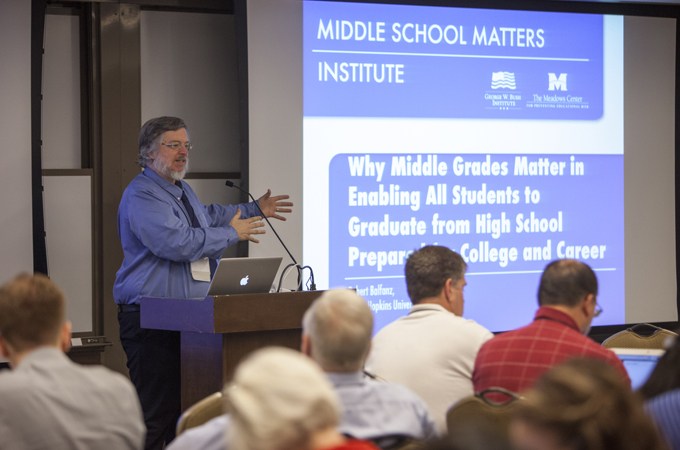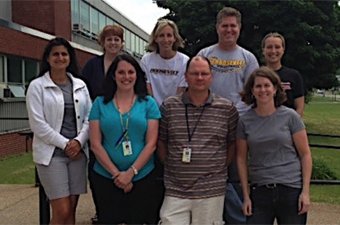This installment of the Middle School Matters Institute Blog focuses on school leadership and establishing student behavior supports.
Contributors:
Robert Balfanz, Ph.D., Johns Hopkins University (Research Perspective)
Dan Scully, Roosevelt Middle School, Erie School District (Practice Perspective)
The Research Perspective
The mission of public schools is to impart academic knowledge and to educate students to become productive, well-functioning citizens. Positive behaviors contribute to students’ success in school, and maladaptive behaviors prohibit students from maximizing their opportunities to learn in school. Past research has found preliminary evidence not just that behavioral skills are important for the social development of students, but also that such behavior, both positive and negative, shows relationships with academic outcomes.
A positive school climate promotes the emotional well-being and growth of every student while providing a safe and secure environment. Teaching and learning are challenging in an environment that poses psychological and physical threats. Therefore, it is important to have common behavioral and academic expectations, recognitions, and firm and fair consequences that are consistently applied across the classes a student attends. It is also necessary to teach, model, and recognize the positive behaviors we want students to employ and to create multiple opportunities for students to learn and demonstrate these skills. Finally, a proactive student support system needs to be built to address the circumstances or individual student needs that drive nonproductive and disruptive behaviors. This support system takes strong school leadership, coordination, professional development, and teamwork among all stakeholders.
Research-based principles and practices related to school leadership and student behavior supports can be applied in middle grade education to improve student outcomes. School leaders and teachers can consider these strategies for establishing a positive climate for learning and for assisting students in demonstrating positive behavior. These research-based strategies enable middle grade students to have the behavior skills they need not only for high school success, but also success in postsecondary education and/or future careers.

Develop Discipline Policies and Procedures
School leaders should provide leadership in developing an appropriate school discipline code that includes the following:
- A description of expected student behavior and conduct
- Mechanisms for teaching, modeling, and recognizing positive behaviors
- Consistently and fairly applied guidelines and consequences for students who do not display appropriate behaviors. Guidelines should not inadvertently lead students to attend school less, get in more trouble, or fail their courses.
Such a code should reflect the input of parents, students, teachers, youth-serving professionals, and community leaders and be informed by current evidence of effective and ineffective strategies and policies. Effective educational leaders have school safety and behavior plans that include systematic, ongoing, and consistent processes that try to prevent and eliminate disruptive behaviors, intimidation, drugs, violence, and gangs in the school.
Support Teachers in Classroom Management
School leaders can support teachers by consistently instructing, modeling, and recognizing appropriate and positive academic and social behaviors across all classrooms. These practices can significantly reduce antisocial and maladaptive behaviors-such as acting out, being disrespectful, or not paying attention-that reduce and inhibit effective classroom instruction and student learning.
Positive behavior needs to be taught like any other skill by breaking it down into concrete, teachable steps, and explaining to students the rationale for learning the skill, creating opportunities for guided and independent practice, prompting and cuing students about the use of the behavioral skill, and recognizing the effective use of the skill. What follows are some sample topics for teachers to use to assist their students in developing appropriate behavior skills:
- How to gain attention from the teacher in an appropriate and respectful manner
- How to gain attention from peers in an appropriate and respectful manner
- How to take turns sharing, communicating ideas, cooperating, and problem-solving in small groups
- Ways to self-monitor and self-manage one’s social behavior and completion of academic work
- How to develop emotional awareness, tolerance, self-regulation of emotions, and personal responsibility
Respond to Individual Student Needs
School leaders can implement a prevention and intervention framework focused on student attendance, behavior, and course performance. An effective framework includes whole-school prevention programs, targeted supports of moderate intensity or duration delivered to groups of students, and cases managed one on one or in small groups. Schools should make early warning indicator data (daily attendance, behavior, and course performance) available to teacher teams and other adults who provide student supports (counselors, community-based organizations, and national service corps members). Schools should also analyze the data to ensure that student supports of sufficient intensity and scale are available. On a regular basis, schools should have teacher teams and other student support providers meet and review the early warning indicator data, assign students to appropriate interventions, monitor student progress and intervention effectiveness, and make adjustments as needed.
Encourage Positive Behavior
Administrators, principals, teachers, and community organizations should work collaboratively to develop extracurricular activities and extended day programs that provide students with opportunities to build upon their strengths and interests and that serve as positive alternatives to situations that can lead to negative behaviors. Examples include youth-service networks, student leadership and peer assistance programs, organized school sports, and academic enrichment programs. These stakeholders should also work together to develop specific programs to prevent drug use and abuse and eliminate gang influence in schools.
One way for middle grade students to develop important academic and healthy behaviors is through activities linked to their developmental needs, including activities for adventure and camaraderie. Service learning, in which teams of students participate in the design of a service project and its execution, and electives that combine rich cognitive content with teamwork, performance, and tangible outcomes (debate, drama, robotics, etc.) over relatively short durations (a few weeks or a month or 2), are particularly well suited to this task.
Below, Dan Scully, of Roosevelt Middle School in Erie, Pennsylvania, a Middle School Matters Showcase School, shares the school’s experiences in implementing research-based practices that promote positive student behavior and, in turn, improve academic outcomes for students.
Reflections From the Field
Our Background
Roosevelt Middle School’s focus on student behavior supports was driven largely by its new, diverse student population. Previously, Roosevelt Middle School served approximately 300 students in grades 7 and 8. As a result of district budget decisions, several schools in our district closed and merged into one at Roosevelt Middle School, and we found ourselves in a rather challenging situation. Our student population doubled, our staff size tripled, and we were expected to adapt to an entirely new administrative team. The new student population consisted of diverse ethnic and socioeconomic groups, with nearly 75% of students from low-socioeconomic, disadvantaged backgrounds.
While attending the Middle School Matters Institute Summer Conference, we realized that the key to our success would be supporting positive student behavior while developing a unique school culture with our new students, staff, and administrative team-while simultaneously transitioning to the Common Core State Standards. As a result, we developed a Middle School Matters Institute Implementation Plan focused on student behavior supports.
Our Goals
Some programs and basic interventions were already in place that offered support and outlined student behavioral expectations. However, we wanted to sharpen our focus on students’ needs for positive behavior supports, and we were especially mindful of the students at risk of eventual dropout. We believe it is imperative to identify these students early and lend supports to ultimately prevent them from dropping out of school. Therefore, we created a Data Team to define risk indicators and criteria and identify students with the greatest degree of need. By charting and reviewing the data, as well as considering teacher input, we further identified the students in need of the most immediate support. This attempt to increase student achievement, decrease discipline incidents (which distract from instruction), and motivate students to stay in school is a lofty goal for any middle school. However, we are committed to ensuring our students receive their high school diplomas and become “college and career ready.”
Our Challenges
We faced several difficulties once the Data Team had identified at-risk students. The first challenge was finding time for the Data Team to discuss and outline a basic educational plan for each student. Developing comprehensive plans is a timely process, making it difficult to assist all students in need. A second challenge was finding time in the school day for targeted students to meet in small groups designed around similar need (e.g., organization, study skills) in a way that did not interfere with students’ core classes. A third challenge was effectively implementing the interventions outlined in students’ plans. Our school often lacked the necessary resources to implement the interventions as intended. As a temporary solution, we made the best possible use of existing resources (staff, time, materials, programs, and processes) until new interventions could be scaled up and implemented with fidelity.
Our Success
We have successfully defined indicators and criteria to identify students at risk of eventual high school dropout. As a result, Roosevelt Middle School will pilot a program for the state of Pennsylvania. The state program will identify students by using many of the indicators we already monitor. Additionally, Pennsylvania’s system has a catalog of interventions (e.g., www.dropoutprevention.org/effective-strategies) that can be implemented and monitored, so we can more closely gauge students’ growth.
Lessons Learned
We learned many lessons this year as we implemented our Middle School Matters Institute Implementation Plan in the area of student behavior supports, including the following:
- Set reasonable, achievable goals.
- Make sure you have all the information, resources, and data to implement plans with fidelity.
- Be patient. Implementation of any new program or initiative takes time and is susceptible to challenges. Make sure your plan addresses all necessary steps and address possible problems or weaknesses ahead of time.
- Don’t bite off more than you can chew. After attending the Middle School Matters Institute Summer Conference last year, we were anxious to implement our plans. We were a bit overzealous and unrealistic about what we could do and by when we could achieve it. We revised our plans and made practical decisions with more realistic deadlines.

References
Balfanz, R. (2010). Putting middle grade students on the graduation path: A policy and practice brief. Westerville, OH: National Middle School Association.
Brookover, W., Beady, C., Flood, P., Schweitzer, J., & Wisenbaker, J. (1979). School social systems and student achievement: Schools can make a difference. New York, NY: Praeger.
Day, C. (2005). Principals who sustain success: Making a difference in challenging circumstances. International Journal of Leadership in Education, 8(4), 273–290.
Epstein, M., Atkins, M., Cullinan, D., Jutash, K., & Weaver, R. (2008). Reducing behavior problems in the elementary school classroom: A practice guide (NCEE #2008-012). Washington, DC: National Center for Education Evaluation and Regional Assistance. Retrieved from http://ies.ed.gov/ncee/wwc/publications/practiceguides
Hurwitz, E., Menacker, J., & Weldon, W. (1996). Critical issue: Developing and maintaining safe schools. Retrieved from http://www.ncrel.org/sdrs/areas/issues/envrnmnt/drugfree/sa200.htm
Marzano, R. J., Walters, T., & McNulty, B. A. (2005). School leadership that works: From research to results. Alexandria, VA: Association for Supervision and Curriculum Development.
Murphy, J. (2009). Turning around failing schools: Policy insights from the corporate, government, and nonprofit sectors. Educational Policy, 23(6), 796–830.
Stephens, R. D. (1995). Safe schools: A handbook for violence prevention. Bloomington, IN: National Educational Service.